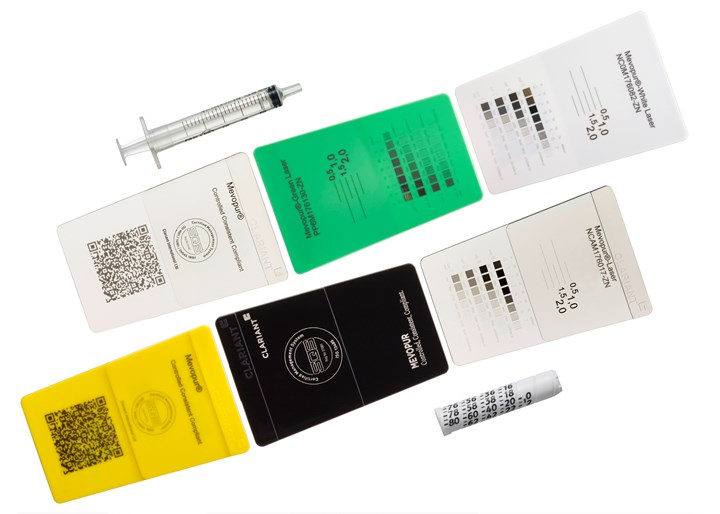Materials: Medical-Grade Compounds and Concentrates for Laser Welding
Clariant supports a ‘Quality by Design’ approach to laser welding of medical devices.
Medical-grade polymer compounds and concentrates for laser-welding developed by Clariant Healthcare Polymer Solutions, Charlotte, N.C, are supported by formulation expertise that can help medical-device manufacturers take a ‘Quality by Design’ (QbD) approach to laser-welding of plastic components. Featured at MD&M West 2020, they expand Clariant’s portfolio of Mevopur ‘medical grade’ materials.
Laser-welding offers numerous advantages in medical and diagnostic applications in terms of speed and reliability. Yet, if the combination of polymer, colorants, part design and processing techniques are not considered in the earliest stages of product development, weld consistency can suffer, and the risk of product failure may become unacceptable, according to global head of marketing & business development Steve Duckworth. Laser welding can develop a high-strength bond without many of the disadvantages of other methods. For example, surfaces do not require pre-treatment and the risk of creating potential leachables from solvent residues or adhesive is eliminated. In addition, high-speed joining of even complex geometries is possible with minimal stress in the joints. Welded components can survive repeated sterilization, if necessary.
However, color choices play a critical role in the ability of one part to transmit laser energy, and the other to absorb laser energy and melt at the bond line. In many applications, color decisions are taken only in the later stages of the development cycle by the marketing team or others not involved in the functional design process. When laser welding. Explains Duckworth, “Traditional approaches to coloration may not work. For example, having a visually opaque black or very dark color that typically uses carbon black would not perform in the laser-transmitting component. Neither would a white component, where a typical pigment used is titanium dioxide.”

Duckworth explains that this is the reason why Clariant takes a ‘QbD’ approach with its customers. “Our team of experts has a thorough knowledge of pigment and additive options for absorbing and transmitting parts, so we can give different color options in a wide range of polymers including PP, ABS, PC, PC/ABS blends and more. In collaboration with laser equipment suppliers, we’ve developed analytical techniques that can be used to screen different solutions to find the best one.”
Once an optimal color has been selected, the distribution of pigments and additives in the plastic component and part-to-part consistency become important. Although masterbatch concentrates added to the host polymer during processing may be convenient for introducing color, the processing equipment, (e.g., injection-molding machines), and the flow-path in the tool, may only allow for poor or inconsistent distribution of the pigments at the targeted weld-line. Using a fully compounded ready to use material may help solve this distribution problem. This is why the company’s Mevopur laser-welding solutions are available in both a concentrated masterbatch form, and as a ready-to-use compound. Both have been manufactured in one of three global Clariant facilities certified to EN: ISO13485- 2016 quality standards. Comprehensive regulatory testing and documentation includes pre-testing of raw-material ingredients to pharmaceutical and medical-device industry standards, DMF, formulation disclosure, etc. Change-control measures reportedly further minimize risk.
Related Content
Understanding the ‘Science’ of Color
And as with all sciences, there are fundamentals that must be considered to do color right. Here’s a helpful start.
Read MoreCommodity Resin Prices Flat to Lower
Major price correction looms for PP, and lower prices are projected for PE, PS, PVC and PET.
Read MoreNew Entrant Heartland Polymers Stepping up as Reliable Supplier
Heartland Polymers’ new Alberta, Canada facility will produce 525 KTA propylene and 525 KTA polypropylene. It is expected to stabilize supply chains across the continent.
Read MoreResin Prices Still Dropping
This downward trajectory is expected to continue, primarily due to slowed demand, lower feedstock costs and adequate-to-ample supplies.
Read MoreRead Next
Recycling Partners Collaborate to Eliminate Production Scrap Waste at NPE2024
A collaboration between show organizer PLASTICS, recycler CPR and size reduction experts WEIMA and Conair will seek to recover and recycle 100% of the parts produced at the show.
Read MoreFor PLASTICS' CEO Seaholm, NPE to Shine Light on Sustainability Successes
With advocacy, communication and sustainability as three main pillars, Seaholm leads a trade association to NPE that ‘is more active today than we have ever been.’
Read MoreLead the Conversation, Change the Conversation
Coverage of single-use plastics can be both misleading and demoralizing. Here are 10 tips for changing the perception of the plastics industry at your company and in your community.
Read More


























